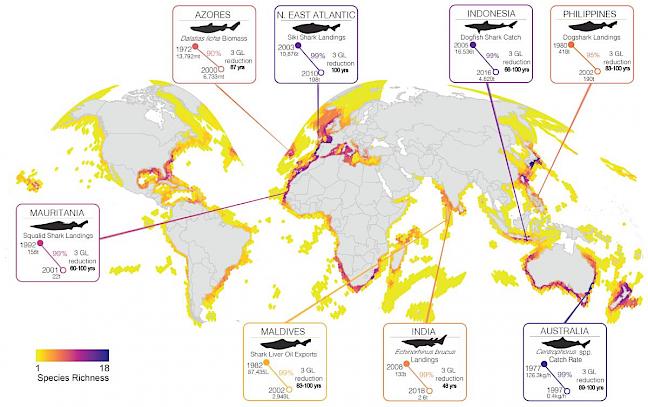Deepwater Sharks and Rays in Deep Trouble
A new paper out today in Science shines a light on the plight of the 521 deepwater sharks and rays and the situation is not good, with the main threat being overfishing.
Research Paper:
Fishing for oil and meat drives irreversible defaunation of deepwater sharks and rays
The species are caught incidentally as part of fisheries targeting other species but are also targeted for their meat and liver oil. The liver oil is used in cosmetics and human health products, including vaccine adjuncts.
Most sharks are susceptible to overfishing because of their life histories - slow growth, late maturation, and having few young. Deepwater sharks are no exception and generally have even more extreme life histories. Some deepwater sharks can take decades to mature and give birth to only one or two pups every few years."
Dr Brit Finucci, Fisheries Scientist, National Institute of Water and Atmospheric Research (NIWA) in New Zealand and lead author of the Science paper.Dr Finucci continues: "In some ways, some deepwater sharks are more similar to marine mammals in terms of their limited ability to withstand and recover from exploitation. However, many marine mammals have now been protected for years, if not decades, while deepwater sharks remain largely unprotected."
Some of the most concerning information highlighted is that even though coastal and deepwater sharks are targeted for their liver oil, the preferred species in the trade are the deepwater species due to the high quality of their oil, also known as the compound squalene. Two-thirds of the threatened deepwater sharks have been used in liver oil products. The history of fisheries for these species is one of short-term mining and collapse.
“As coastal fisheries become depleted, fishing effort has moved further offshore and into deeper waters,” said Dr Cassandra Rigby, Adjunct Senior Research Fellow at James Cook University and one of the authors. “We know this is impacting deepwater sharks because we're seeing new species records in locations where there was no known deepwater fishing previously. Where targeted fishing has occurred, deepwater shark populations can decline fast and hard, and deepwater sharks are unlikely to easily recover, if recover at all, because of their very sensitive biology.”

The paper notes the urgent need for the trade to become legal, traceable, and sustainable, a far cry from where it is now. The Convention on International Trade in Endangered Species of Wild Fauna and Flora (CITES) is raised as a possible tool in the management toolbox to use to get the trade under better control and sustainable.
“Since 2008 a shark working group of CITES has been raising the Gulper Sharks as a deepwater species of concern. We have seen increasing use of CITES to bring trade in shark and ray products under control," said Glenn Sant, TRAFFIC's Senior Advisor Fisheries Trade and Traceability and one of the authors.
It’s about time we take a serious look at using CITES to stave off extinction for this threatened group of sharks and see that the trade in their products is legal, traceable and sustainable. Deepwater sharks have basically been out of sight and out of mind when it comes to their management and protection.”
Glenn Sant, TRAFFIC's Senior Advisor Fisheries Trade and Traceability and one of the authors
The crucial role that CIT'ES plays in regulating trade in commercially significant marine species was highlighted at CITES 19th Conference of the Parties to the Convention (CITES COP19). Parties supported all proposals to list 104 shark and ray species consisting of hammerhead sharks, guitarfish and requiem sharks, like the Blue Shark, and three Indo-Pacific sea cucumbers in Appendix II.
Notes:
Ref to CITES 2008 noting Gulper Sharks as a species of concern https://cites.org/sites/default/files/eng/com/ac/23/E23-15-02.pdf
For more information: https://bit.ly/SharksInTheDark



